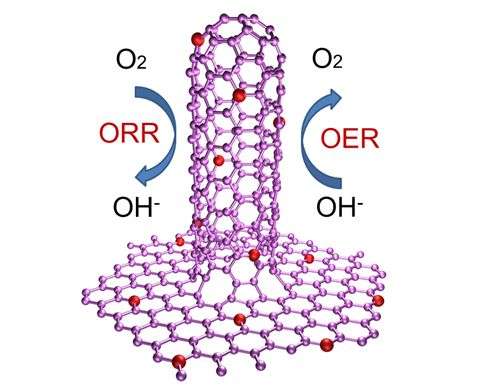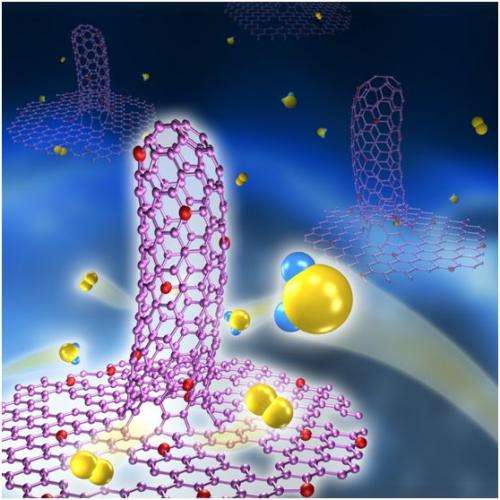Rational hybridization of N-doped graphene/carbon nanotubes for oxygen reduction and oxygen evolution reaction

Scientists at Tsinghua University, China, and Nanyang Technological University, Singapore, have designed an intrinsic-disperse nanocarbon architecture hybridizing N-doped graphene and SWCNTs, which can serve as a superior bifunctional electrocatalyst for both oxygen reduction and evolution reactions.
Nowadays, renewable and high-capacity energy systems like fuel cells and metal-air batteries are highly desired to sustainably fuel society. "As the key electrode reactions for such energy systems, ORR and OER, short for oxygen reduction and oxygen evolution reaction, are multi-electron process and kinetically sluggish. Consequently, high efficiency electrocatalysts for these reactions are needed to boost the reaction rate," says Dr. Qiang Zhang, an associate professor at Department of Chemical Engineering, Tsinghua University. "In spite of high catalytic activity, the conventional noble metal catalysts like Pt, Ru, and Ir, are suffered from the high cost and poor stability. As a result, scientists are seeking substitute catalysts from non-noble metal and even non-metal materials. Heteroatom-doped nanocarbon materials afford much improved reactivity and catalytic performance. Our group explored the in situ growth of N-doped graphene and SWCNT hybrids and their superior electrocatalytic performance for ORR and OER."
"The layered double hydroxides were employed as the bifunctional catalyst for the simultaneous growth of graphene and SWCNTs, forming the three dimensional interconnected network," Prof. Fei Wei tells Phys.org.
Actually, Zhang's group has done a lot of research on the synthesis of hierarchical nanocarbon materials with the layered double hydroxides as the catalysts and achieved great progress and produced many excellent papers. "As for the two typical nanocarbon materials, 1D CNTs and 2D graphene nanosheets, both of them are inclined to aggregate or stack with each other due to the strong van der Waals forces. That hinders the full utilization of the active sites for catalytic reactions. In fact, the integration of graphene and CNTs into a hybrid material is quite a promising strategy to enhance the dispersion of graphene and CNTs, to inherit the advantages of both graphene and CNTs, and to obtain an efficient and effective electronic and thermal conductive 3D network," Qiang says. "The FeMoMgAl LDHs-derived bifunctional catalysts embedded with thermally stable Fe NPs not only served as an efficient catalyst for the growth of N-doped SWCNTs, but also supplied a lamellar substrate for the templated deposition of N-doped graphene. Therefore, the simultaneous growth of N-doped graphene and SWCNTs can be achieved with the covalent C-C bonding connection."

Based on this concept, Gui-Li Tian, a graduate student and the first author, developed an in-situ chemical vapor deposition strategy for the graphene/SWCNT hybrid synthesis. "N-doped Graphene and SWCNTs are intrinsically dispersed in this novel carbon architecture and the N-containing functional groups well dispersed in the conductive scaffold. The as-fabricated hybrids are with a large surface area, high porosity and also high graphitic degree. All these characters render the N-doped graphene/SWCNT hybrids with a high ORR activity, much superior to two constituent components and even comparable to the commercial 20 wt% Pt/C catalysts with much better durability and resistance to crossover effect," says Gui-Li. What's more, they demonstrated that such novel carbon architecture is also electrocatalytically active for OER.
"This indicated that the hybrid material is a promising bifunctional electrocatalyst for the regenerative fuel cells and rechargeable metal-air batteries involving oxygen electrochemistry," says Dr. Dingshan Yu at Nanyang Technological University, Singapore.
"We foresee that compared with random graphene and CNTs, more potential applications may arise if the enhanced electrical and optical properties of doped graphene/CNT hybrids were fully exploited," says Qiang. Additionally, this work also provides a structural platform toward the design of 3D interconnect materials with extraordinary electron pathways as well as tunable surface/interface that can be used in areas, such as catalysis, separation, drug delivery, energy conversion and storage.
More information: Tian GL, Zhao MQ, Yu DS, Kong XY, Huang JQ, Zhang Q, Wei F. "Nitrogen-Doped Graphene/Carbon Nanotube Hybrids: In-Situ Formation on Bifunctional Catalysts and Their Superior Electrocatalytic Activity for Oxygen Reduction Reaction." Small 2014. 10(11), 2251-2259. doi:10.1002/ smll.201303715.
Journal information: Small
Provided by Tsinghua University




















